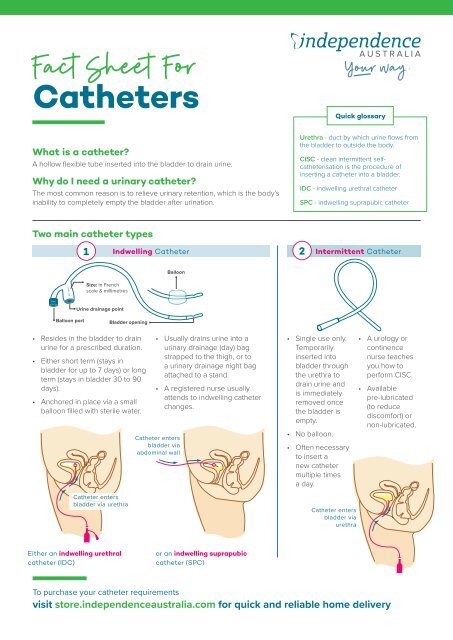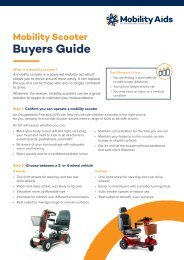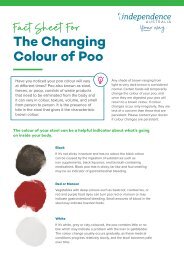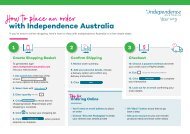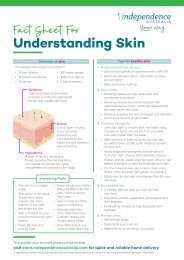Fact Sheet for Catheters
For everything there is to know about Catheters, check out Independence Australia's guide to understanding catheters.
For everything there is to know about Catheters, check out Independence Australia's guide to understanding catheters.
Create successful ePaper yourself
Turn your PDF publications into a flip-book with our unique Google optimized e-Paper software.
<strong>Fact</strong> <strong>Sheet</strong> For<br />
<strong>Catheters</strong><br />
Quick glossary<br />
What is a catheter?<br />
A hollow flexible tube inserted into the bladder to drain urine.<br />
Why do I need a urinary catheter?<br />
The most common reason is to relieve urinary retention, which is the body’s<br />
inability to completely empty the bladder after urination.<br />
Urethra - duct by which urine flows from<br />
the bladder to outside the body.<br />
CISC - clean intermittent selfcatheterisation<br />
is the procedure of<br />
inserting a catheter into a bladder.<br />
IDC - indwelling urethral catheter<br />
SPC - indwelling suprapubic catheter<br />
Two main catheter types<br />
1 Indwelling Catheter<br />
2<br />
Intermittent Catheter<br />
Balloon<br />
Size: In French<br />
scale & millimetres<br />
18Fr - 60mm<br />
10mm<br />
Urine drainage point<br />
Balloon port<br />
Bladder opening<br />
• Resides in the bladder to drain<br />
urine <strong>for</strong> a prescribed duration.<br />
• Either short term (stays in<br />
bladder <strong>for</strong> up to 7 days) or long<br />
term (stays in bladder 30 to 90<br />
days).<br />
• Anchored in place via a small<br />
balloon filled with sterile water.<br />
Catheter enters<br />
bladder via urethra<br />
• Usually drains urine into a<br />
urinary drainage (day) bag<br />
strapped to the thigh, or to<br />
a urinary drainage night bag<br />
attached to a stand.<br />
• A registered nurse usually<br />
attends to indwelling catheter<br />
changes.<br />
Catheter enters<br />
bladder via<br />
abdominal wall<br />
• Single use only.<br />
Temporarily<br />
inserted into<br />
bladder through<br />
the urethra to<br />
drain urine and<br />
is immediately<br />
removed once<br />
the bladder is<br />
empty.<br />
• No balloon.<br />
• Often necessary<br />
to insert a<br />
new catheter<br />
multiple times<br />
a day.<br />
Catheter enters<br />
bladder via<br />
urethra<br />
• A urology or<br />
continence<br />
nurse teaches<br />
you how to<br />
per<strong>for</strong>m CISC.<br />
• Available<br />
pre-lubricated<br />
(to reduce<br />
discom<strong>for</strong>t) or<br />
non-lubricated.<br />
Either an indwelling urethral<br />
catheter (IDC)<br />
or an indwelling suprapubic<br />
catheter (SPC)<br />
To purchase your catheter requirements<br />
visit store.independenceaustralia.com <strong>for</strong> quick and reliable home delivery
Catheter usage tips<br />
• Secure to your thigh if<br />
you have an IDC or to<br />
your belly if you have<br />
a SPC using a catheter<br />
fixation device.<br />
• Avoid excessive<br />
tension when securing<br />
a catheter to prevent<br />
accidental removal or<br />
urethral trauma.<br />
• Empty urinary drainage<br />
bags when they are<br />
¾ full.<br />
Indwelling <strong>Catheters</strong><br />
• Replace day drainage<br />
bags every 7 days with<br />
a sterile day drainage<br />
bag.<br />
• Attach night drainage<br />
bag to a drainage bag<br />
stand.<br />
• Position all drainage<br />
bags below the level of<br />
the bladder.<br />
• CISC does not require a<br />
sterile technique.<br />
• Wash your hands with<br />
soap and warm water<br />
or a wet one be<strong>for</strong>e<br />
per<strong>for</strong>ming a CISC.<br />
• Drain the urine<br />
completely from<br />
your bladder be<strong>for</strong>e<br />
removing the catheter<br />
once it is inserted into<br />
the bladder.<br />
Intermittent <strong>Catheters</strong><br />
• Use a lubricating gel<br />
prior to insertion to<br />
reduce urethral friction.<br />
• Reduce the steps<br />
involved in a CISC<br />
procedure with a prelubricated<br />
non-touch<br />
sleeve intermittent<br />
catheter.<br />
• Dispose of catheters in<br />
a plastic bag and into<br />
the bin.<br />
Be<strong>for</strong>e you buy a catheter<br />
To ensure the correct catheter is purchased <strong>for</strong> your needs, please ask your health professional<br />
to confirm the following details. Use this in<strong>for</strong>mation to place your catheter order.<br />
1<br />
Catheter type<br />
See overleaf. Indwelling (IDC or SPC) or Intermittent.<br />
Fill in with your catheter details<br />
2<br />
3<br />
4<br />
Catheter tip<br />
Type of catheter tip that sits in the bladder once inserted. Choice is<br />
dependent on difficulty of insertion or the sediment build-up that can<br />
occur because of catheterisation. Most common tip is known as a straight<br />
rounded tip.<br />
Coude tip<br />
Straight<br />
6 FG 8 FG 10 FG 12 FG 14 FG 16 FG 18 FG 20 FG 22 FG<br />
Open<br />
ended tip<br />
Catheter size<br />
Diameter of catheter using a unit of measurement called the French<br />
gauge system. Abbreviated as either FG, Fr or Ch. 1 French = 1/3 mm.<br />
Available in adult sizes from 12FG to 22FG.<br />
Paediatric:<br />
6-10FG<br />
Adult Female:<br />
12-14FG<br />
Adult Male:<br />
14-18FG<br />
Clot Retention:<br />
20-22FG<br />
rounded tip<br />
Catheter length<br />
Length of the catheter also commonly referred to as either male length<br />
between 38 to 42cm or female length between 16 to 22cm.<br />
5<br />
Catheter material<br />
Materials vary from silicone, latex or polyvinyl chloride (PVC).<br />
6<br />
Catheter balloon volume<br />
Volume is measured in cubic centimetres (cc) and varies from 5cc to<br />
30 cc. Most common is 10cc <strong>for</strong> long term catheterisation.<br />
To purchase your catheter requirements<br />
visit store.independenceaustralia.com <strong>for</strong> quick and reliable home delivery


